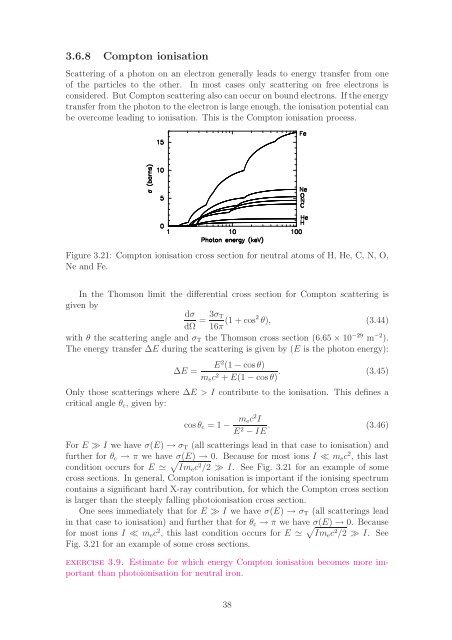Thermal X-ray radiation (PDF) - SRON
Thermal X-ray radiation (PDF) - SRON
Thermal X-ray radiation (PDF) - SRON
You also want an ePaper? Increase the reach of your titles
YUMPU automatically turns print PDFs into web optimized ePapers that Google loves.
3.6.8 Compton ionisation<br />
Scattering of a photon on an electron generally leads to energy transfer from one<br />
of the particles to the other. In most cases only scattering on free electrons is<br />
considered. But Compton scattering also can occur on bound electrons. If the energy<br />
transfer from the photon to the electron is large enough, the ionisation potential can<br />
be overcome leading to ionisation. This is the Compton ionisation process.<br />
Figure 3.21: Compton ionisation cross section for neutral atoms of H, He, C, N, O,<br />
Ne and Fe.<br />
In the Thomson limit the differential cross section for Compton scattering is<br />
given by<br />
dσ<br />
dΩ = 3σ T<br />
16π (1 + cos2 θ), (3.44)<br />
with θ the scattering angle and σ T the Thomson cross section (6.65 × 10 −29 m −2 ).<br />
The energy transfer ∆E during the scattering is given by (E is the photon energy):<br />
∆E =<br />
E 2 (1 − cosθ)<br />
m e c 2 + E(1 − cosθ) . (3.45)<br />
Only those scatterings where ∆E > I contribute to the ionisation. This defines a<br />
critical angle θ c , given by:<br />
cosθ c = 1 −<br />
m ec 2 I<br />
E 2 − IE . (3.46)<br />
For E ≫ I we have σ(E) → σ T (all scatterings lead in that case to ionisation) and<br />
further for θ c → π we have σ(E) → 0. Because for most ions I ≪ m e c 2 , this last<br />
condition occurs for E ≃ √ Im e c 2 /2 ≫ I. See Fig. 3.21 for an example of some<br />
cross sections. In general, Compton ionisation is important if the ionising spectrum<br />
contains a significant hard X-<strong>ray</strong> contribution, for which the Compton cross section<br />
is larger than the steeply falling photoionisation cross section.<br />
One sees immediately that for E ≫ I we have σ(E) → σ T (all scatterings lead<br />
in that case to ionisation) and further that for θ c → π we have σ(E) → 0. Because<br />
for most ions I ≪ m e c 2 , this last condition occurs for E ≃ √ Im e c 2 /2 ≫ I. See<br />
Fig. 3.21 for an example of some cross sections.<br />
exercise 3.9. Estimate for which energy Compton ionisation becomes more important<br />
than photoionisation for neutral iron.<br />
38
















